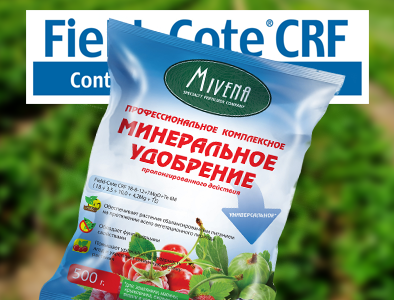The importance of nitrogen and phosphorus in plant nutrition
Ian Carlo Bottinelli Wolleter, Agronomist-consultant, nutrition specialist plants
Nitrogen
Nitrogen is the element that superiority has a big impact on productivity and profitability of crops. This element can be the culprit of successful seasons, or failures, in the latter case almost always due to excess.
Actually, often there is an excess of nitrogen than a disadvantage. The amount of nitrogen applied can directly affect the profitability of the culture, through over application and through collateral damage.
 Photo from:ogorod.guru
Photo from:ogorod.guru
Too much nitrogen can directly and indirectly cause: the softness of the fruit, delayed ripening, poor color, thin skin, susceptibility to the attacks of fungi, excessive shading, and the excess of gibberellins, the development of laterals, reduced fertility and kidney disease, shedding of flowers and falling of the fruit after the ovary, bitter pit of the fruit, etc.
Consequently, the use of nitrogen fertilizers gradual return or release is a tool proven agronomic efficiency in terms of control doses of fertilizers in key cultural periods.
When applying humic acids in combination with sources of urea and ammonium formed more stable compounds that are less washed out. In addition, sulfur has the effect of slowing down nitrification of these sources of nitrogen in the soil. For example, a nutrition program that combines humic acid and ammonium sulphate, is the "home" method of creating a gradual release fertilizer. Under these conditions nitrogen remains in the root zone up to 40 days depending on temperature.
This strategy is quite recommended for use on crops or fruit garden in the growth period, that allows you to create a synergy of elements which, in turn, help us to avoid an excessive increase levels of nitrogen circulating in the SAP of plants, supporting a more balanced and gradual nutrition. So it is not recommended to do after the harvest, when for a short time is necessary to give the elements that contribute to the formation of reserves in roots and wood.
Nitrogen is the most important element of power in the metabolic system of plants, but the ideal strategy should always be accompanied by sulphur and calcium. Sulfur is an essential component of the two key amino acids associated with the development (cysteine and methionine), and calcium is a structural component of plant tissue and fruit quality. Nitrogen generates biomass, but without sulfur and calcium will not product quality.
Foliar application of urea is another very effective tool to "revive" fruit garden with a low level of development, for example, because of the drought. Urea foliar application promotes the opening of stomata, and can be used separately or together with trace elements. In addition, the urea enters the plant as amino group (NH2+), which quickly turns into amino acids and proteins. On fruit crops foliar application urea can be applied after harvest to create the inventory in the plant.
Molybdenum is a trace element, which affects the metabolic activity of nitrogen playing a key role in the conversion of nitrates to amino acids in the plant. The lack in the soil or in the plant leads to the accumulation of nitrates in leaves and juice, creating vegetative mass, but fully exposing the plant to the risk of physiological disorders or diseases.
If we assume that the ultimate objective of nitrogen fertilizer is the formation of plant amino acids (all this happens when negative energy process plants), an interesting strategy is to control the effects of excessive use of nitrogen is a partial "substitution" units of nitrogen per liter of free amino acids in foliar application. This strategy makes sense in situations of heat and water stress during fruiting, etc. In cases when you don't want or can't give fertilizer to apply nitrogen and forcing the plant to expend energy in the early stages of the metabolism.
After harvest, the necessary nitrogen, phosphorus, potassium, calcium and micronutrients to be applied for the creation of reserves. Again, it is preferable to use nitrogen forms rapid absorption (nitrates) in order to accelerate the formation of amino acids, which in this case are working for the future nutrition of the kidneys, which will require energy and nutrients next spring.
The use of fulvic acid by making the root increases the absorption of potassium, as they form fulvate potassium components that is much more stable in soil and are better absorbed by the plant.
In water deficit conditions, foliar application of potassium will have a very positive effect on the yield (this element translocases transpiration stream of the plant). Application 5 kg/ha of potassium sulphate combined with fulvic acid will have a very important influence on the metabolism of plants, reducing further the symptoms of water stress.
Foliar application of urea is used rarely but very effective for the "revival" of the orchard with low level of development due to the root of drought. When urea is applied by foliar way, it penetrates into the plant in the form of amino groups, which quickly turns into amino acids and proteins. When urea is applied to soils, it almost always is absorbed in the form of nitrates, and if there is no molybdenum in the leaves, the nitrates accumulate.
For the same reason, never forget about the use of complex fertilizers for foliar application.
Phosphorus
The word that best describes the role of phosphorus in plant nutrition is ENERGY. Phosphorus (P) is the cornerstone of ATP which controls each enzymatic reaction of the plant. ATF, in fact, is battery life. Phosphorus is also a major element necessary for the immune process plants (systemic acquired resistance (SAR), clearly working through phosphites). In addition, the production of glucose (°Brix) in the process of photosynthesis is based largely on the enzymes on the basis of phosphate.
Known issues fixing the phosphate anions to the trivalent cation of aluminum in soils derived from volcanic ash from southern Chile. In this case, there are two proven strategies of destruction the effect of aluminum on the phosphorus availability for crops which are ionic soil management. The first is to increase the amount of exchange bases by competition to aluminum from the magnesium and calcium in the fixation of phosphate ion; and second, to create a "Delta" of free phosphate using phosphorus ion various forms in high doses.
In the North there is another type of binding that phosphorus is lost in alkaline soils is mainly due to an excess of calcium carbonate in irrigation water, or calcium hardness. The phosphate is the anion associated with the cation of calcium, forming compounds that the plant does not absorb. In this case, the strategy is to dissolve such a rocky phosphorus applying fertilizer with an acid reaction. There can be used ammonium compounds, urea, sulfates, phosphoric acid, nitric acid, probably sulfuric, carbonic, humic and fulvic acids.
But not so simple. Every time when such acidifying "strikes", the major part of the microbial flora which gives life to the soil decreases sharply due to the influence of pH. In this regard, to date, EM (effective microorganisms) manufactured with combinations of specialized strains of bacteria of the Azotobacter type, which in combination with such proven visuamobile phosphate as Bacillus subtilis, are another proven and sustainable tool for solving this problem.
Phosphorus is an immobile element, which means that it does not move in the soil and in the plant from old leaves to young and Vice versa, but he moves well through the juice. Phosphoric acid applied in the morning, can be detected in the juice of the leaf of the afternoon.
The need for phosphorus in plants is well understood, and farmers have learned well that phosphorus is used mainly before flowering and for increasing the root system. It is interesting to note that, despite this proven management technique, also confirmed the increase of the phosphorus concentration closer to maturation. This is understandable because the plant is supposed to speed up metabolism, requiring more energy for the last 100 meters of the race. Therefore, at this stage it is recommended to maintain the basic introduction, which at least 15-20% annual rate.
In field trials we were able to verify that with increasing applications of magnesium in the soil solution (the decrease in the ratio of K/Mg) in parallel to create a positive impact on the uptake of phosphorus.
Another important relationship is observed between the phosphorus and zinc. The literature generally refers to the ratio of 10/1 between phosphorus and zinc. For example, if a soil test shows phosphorus is 7 ppm and 0.7 ppm of zinc, from a technical point of view, these two elements are scarce. However, the ratio between them is the correct one (10:1). Providing this ratio, obviously, at levels adequate for both items is very important in the analysis of the soil solution.
The biggest problem with the zinc in the soil, usually associated with an excess of phosphate, which prevents absorption of zinc. In this regard, the excess of bird droppings and/or phosphate adjustments can cause zinc deficiency in the plant.
Phosphorus is a structural component of nucleic acids and membranes of each plant cell, a factor of plant defense system and plays a key role in energy processes of the plant. An element that deserves a more accurate assessment when developing the programme of feed and fertilizer.
Inga Kostenko, Mivena, Ukraine
Anna Ustymenko, Club Sirius Agro Plant










